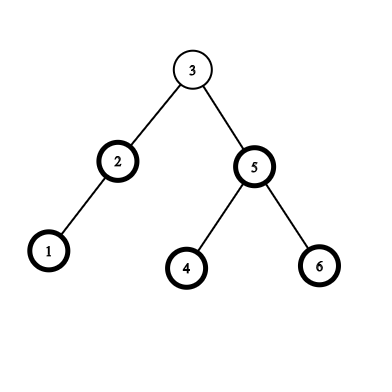Table of Contents
Problem Statement
“K’th Largest Element in BST when modification to BST is not allowed” states that you are given a binary search tree and you need to find the kth largest element. This means that when all the elements of the binary search tree are arranged in descending order. Then we need to return the kth element from the sequence.
Example
Input

k=4
3
Explanation: The image of the tree is shown above. And we need to find 4th largest element. So if we arrange them in the ascending order, they are {1, 2, 3, 4, 5, 6}. So the 4th largest element is 3rd smallest element. Thus we return 3 as output.
Approach to find K’th Largest Element in BST when modification to BST is not allowed
We have already done a similar question, where we found the k-th smallest element in the BST. The problem is just a modification over that. In the previous post, we discussed solutions for that question. The first approach was to modify the tree data structure. While the other was to run an in-order traversal for the binary search tree and keep counting the nodes. Since the previous question was to return the kth smallest. We simply counted the number of nodes and once the count was equal to k we returned the value on that node.
Naive Approach
Here the situation is a bit different. We need to find the kth largest element, we can first find the total number of nodes in the tree and then subtract the k-1 from the total number of nodes. Now we find n-k+1 smallest node, where n is the total number of nodes in the binary search tree. But this approach will require two passes or two traversals over the tree.
Efficient Approach
We can efficiently solve the problem if we can find the nodes in descending order. That way we won’t need to find the total number of nodes in the tree. An efficient approach will be to do reverse-inorder traversal of the tree. The reverse inorder traversal of the binary search tree traverses the tree in descending order. So while doing reverse in-order, we will keep on counting the nodes. and when the count becomes equal to k, we return the value on that node.
Code
C++ code to find K’th Largest Element in BST when modification to BST is not allowed
#include <bits/stdc++.h>
using namespace std;
struct node{
int data;
node *left;
node *right;
} ;
node* create(int data){
node * tmp = new node();
tmp->data = data;
tmp->left = tmp->right = NULL;
return tmp;
}
// normally insert the node in BST
node* insert(node* root, int x)
{
if (root == NULL)
return create(x);
if(x<root->data)
root->left = insert(root->left, x);
else if(x>root->data)
root->right = insert(root->right, x);
return root;
}
node* findKthLargest(node* root, int& k)
{
// base case
if(!root)
return NULL;
node *right = findKthLargest(root->right, k);
if(right)
return right;
// if current element is kth largest
if(k==1)
return root;
// if the kth largest is not found in the left subtree
// search in left subtree
k--;
return findKthLargest(root->left, k);
}
int main()
{
node *root = NULL;
int n;cin>>n;
for(int i=0;i<n;i++){
int element;cin>>element;
root = insert(root, element);
}
int k;cin>>k;
node* res = findKthLargest(root, k);
if(res == NULL)
cout<<"No kth largest found";
else
cout<<"Kth largest element is "<<res->data;
}
6 3 2 1 5 4 6 4
Kth largest element is 3
Java code to find K’th Largest Element in BST when modification to BST is not allowed
import java.util.*;
import java.lang.*;
import java.io.*;
class node{
int data;
node left;
node right;
}
class Tree{
static node root;
static int count;
static node create(int data){
node tmp = new node();
tmp.data = data;
tmp.left = null;
tmp.right = null;
return tmp;
}
static node insert(node root, int x)
{
if (root == null)
return create(x);
if(x<root.data)
root.left = insert(root.left, x);
else if(x>root.data)
root.right = insert(root.right, x);
return root;
}
static node findKthLargest(node root, int k)
{
// base case
if(root == null)
return null;
node right = findKthLargest(root.right, k);
if(right != null)
return right;
count++;
// if current element is kth largest
if(k==count)
return root;
// if the kth largest is not found in the left subtree
// search in left subtree
return findKthLargest(root.left, k);
}
public static void main(String[] args)
{
Scanner sc = new Scanner(System.in);
int n = sc.nextInt();
for(int i=0;i<n;i++){
int element = sc.nextInt();
root = insert(root, element);
}
int k = sc.nextInt();
count = 0;
node res = findKthLargest(root, k);
if(res == null)
System.out.println("No kth largest found");
else
System.out.println("Kth largest element is "+res.data);
}
}6 3 2 1 5 4 6 4
Kth largest element is 3
Complexity Analysis
Time Complexity
O(N), because we have simply traversed through the BST, and since the BST had only N nodes. We have achieved a linear time complexity of O(N).
Space Complexity
O(1), we have used only constant extra space. Thus only this algorithm has constant space complexity but the program as a whole has linear space complexity. Because we are storing N binary tree nodes.